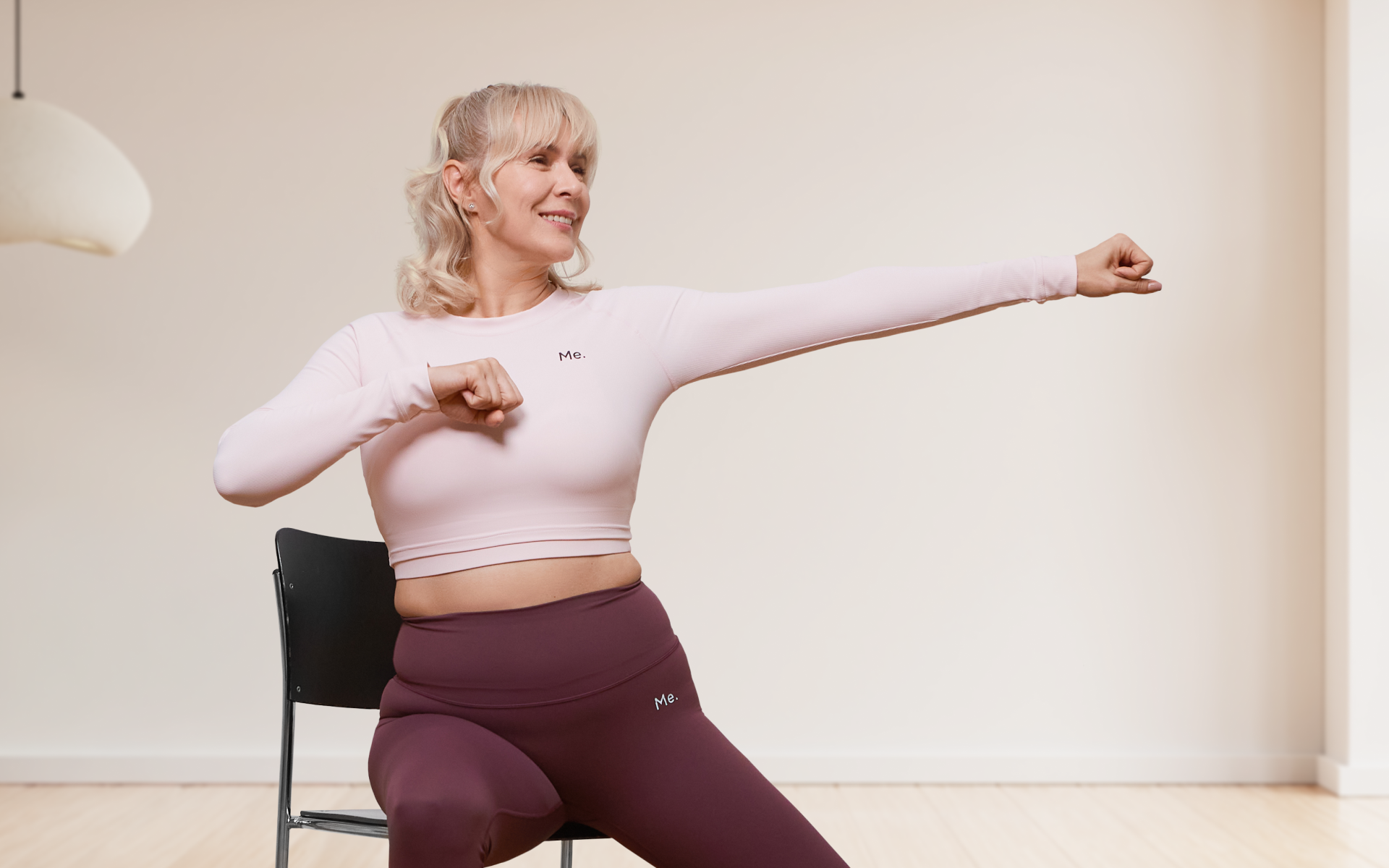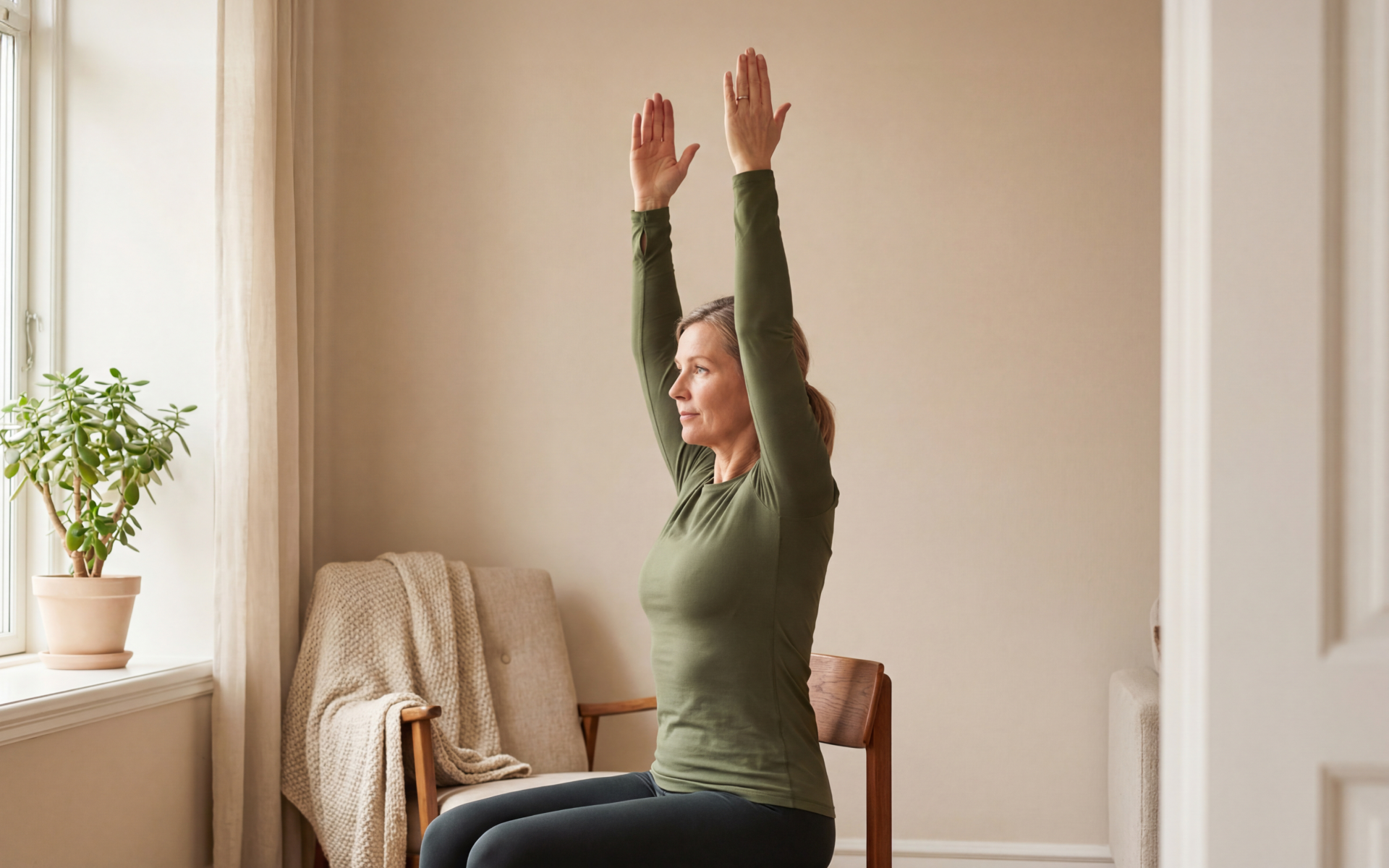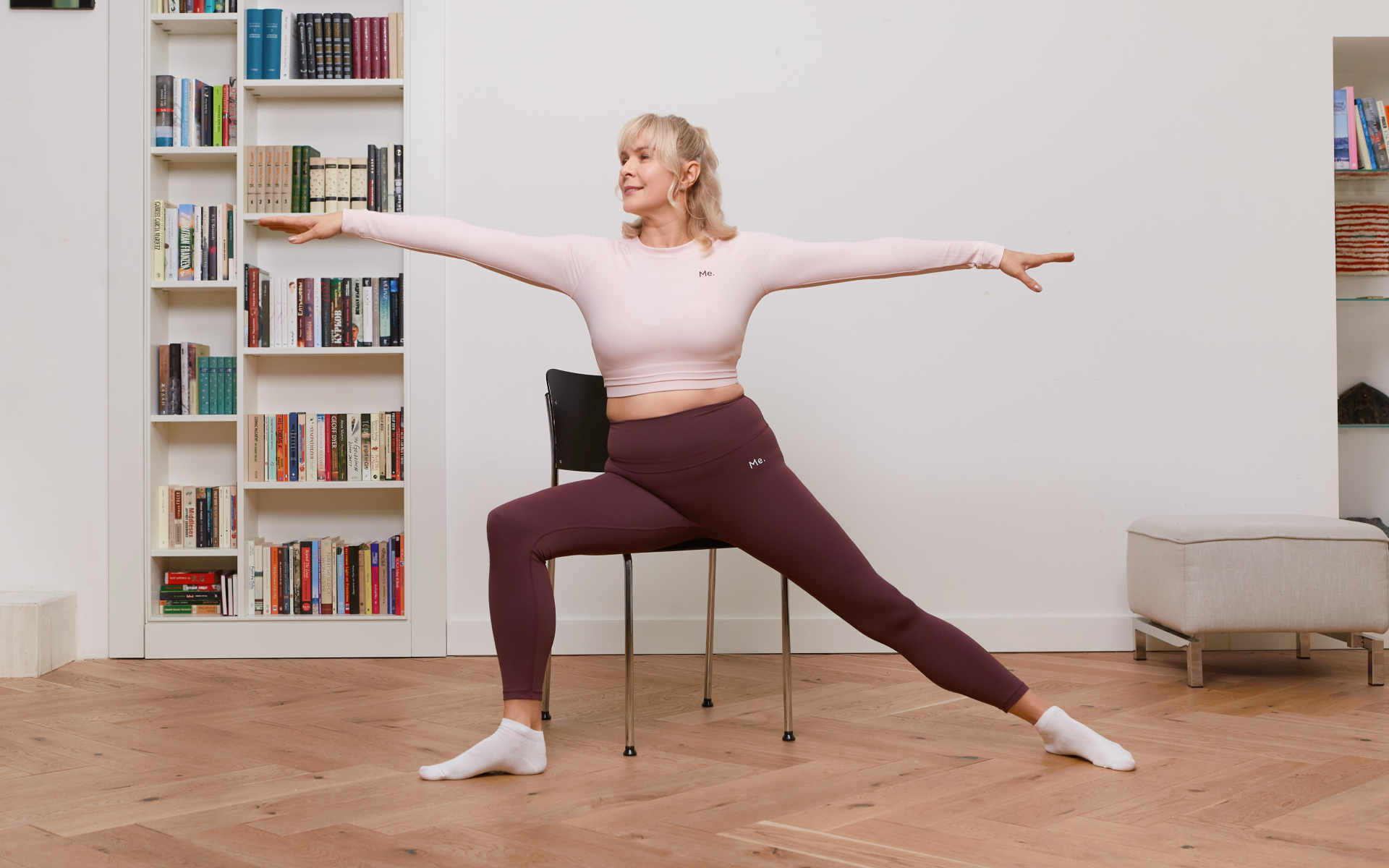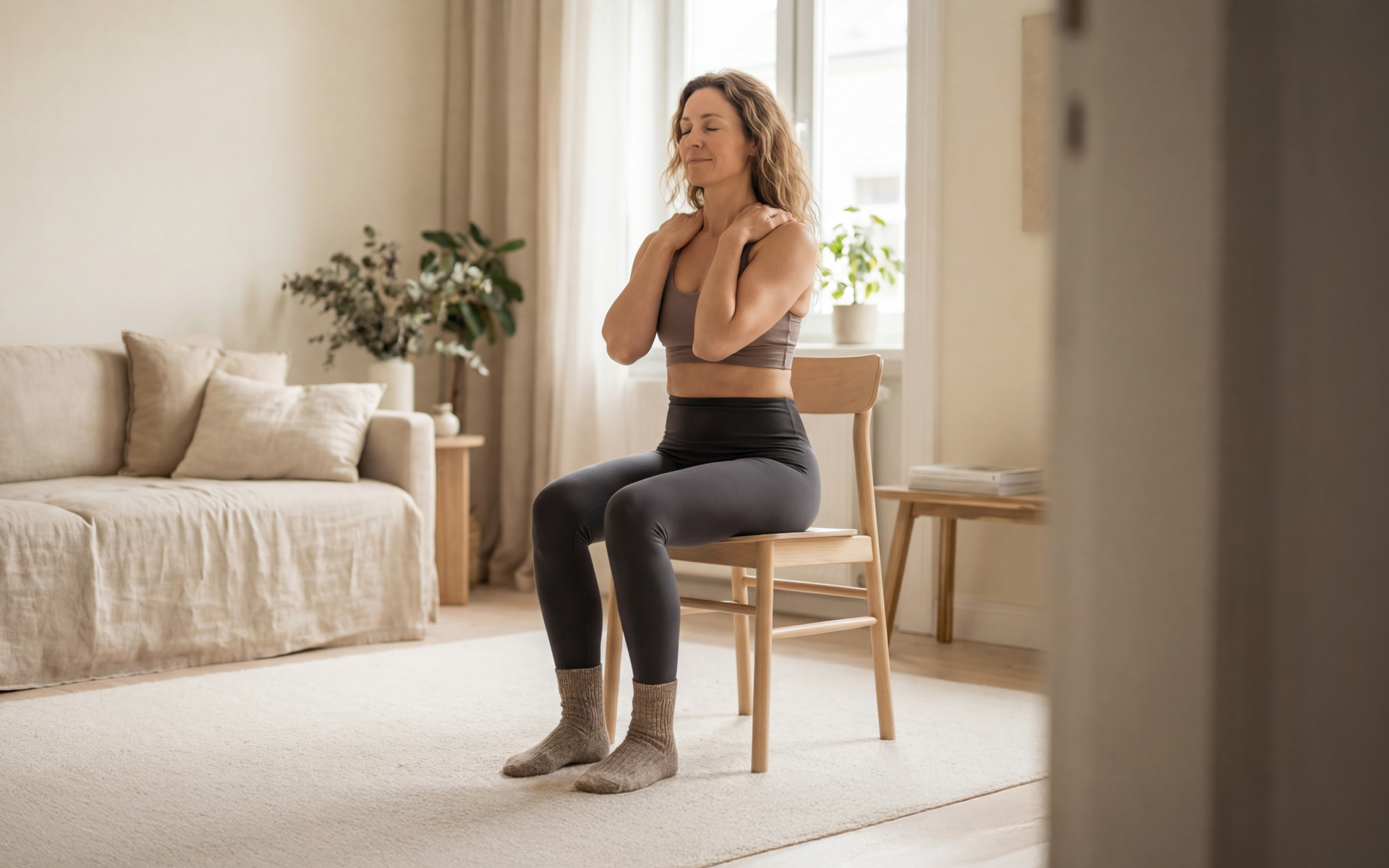Building upper-body strength isn’t only for the young. As we age, it becomes even more important to maintain our independence and quality of life. Seniors with strong arms and shoulders find performing routine activities such as carrying groceries or lifting their grandkids relatively easier. On the flip side, those who lose their strength can have problems with posture, balance, and bone density (1).
Beyond the physical perks, upper-body exercises can also be a mood-lifter (2). The release of endorphins can leave you feeling happier and more energetic. It can also be an excellent social activity, allowing you to connect and bond with like-minded people. If you’re progressing in years and want to stay fit, you should definitely consider performing upper-body exercises. And if you’ve never worked out before, chair exercises could be a good place to start.
In this article, we’ve rounded up a few upper-body chair exercises for seniors, their benefits, and the frequency of performing them. Remember, it’s never too late to invest in your strength and well-being. Keep scrolling if you’re all set to take charge and take your fitness to a new level!
What Are the Best Upper-Body Chair Exercises for Seniors?
We all understand that exercise is essential for people of all ages. Chair exercises can be an ideal way to get your body moving if you’re a beginner or have little experience with exercise. For these exercises, you should look for a sturdy chair that doesn’t have wheels or is too lightweight. You should be able to sit with your feet flat on the floor and your knees bent at right angles.
Once your physician gives you the go-ahead, you can craft a comprehensive exercise routine that targets all the muscles while remaining seated in the chair. Some tips to remember when doing upper body chair exercises include:
- Wear loose and comfortable clothes that allow free movement.
- Wear non-slip and supportive shoes.
- Ensure that the chair is clear of any obstacles or tripping hazards. You can even place the chair against a wall to add even more stability to it.
- Keep a water bottle nearby and take small sips throughout your workout to stay hydrated.
- Focus on good posture and form, allowing you to perform exercises correctly and prevent strain.
After implementing all these tips, you can perform the following upper-body chair exercises for seniors. These selections are some of our favorite options for beginners and seniors who are hoping to increase their daily movement. They include:
Seated Shoulder Press
This movement will have you pressing your arms overhead and fully extending your elbows. It can help improve mobility, strength, and balance (3). The steps to perform this exercise are as follows:
- Start by trying this movement with no weight at all. This will help ensure you have the proper form down.
- Once you’ve perfected this movement, feel free to grab some light weights or sit on a resistance band.
- Scoot back in your chair and keep your back against the backrest.
- Tighten your tummy muscles.
- Move your arms out to the side to form a T. From here, bend your elbows and lower your elbows so they are slightly under your shoulders. Make sure to keep your chest up too.
- Holding weights, extend your elbows straight up overhead, but don’t let them touch at the top of the movement.
- Slowly bring your arms back down, keeping your elbows out.
- Keep going and remember to feel a gentle pinch in your upper back.
Looking for a way to break the vicious cycle of weight loss and tone up all the jiggly parts? Watch the extra pounds fly off and your muscles firm up with the BetterMe: Health Coaching app!
Seated Chest Press
This exercise doesn’t only use the chest muscles, it also involves the shoulders and triceps (5). It is also considered a compound movement as it targets multiple muscle groups simultaneously. This movement is similar to the shoulder press but instead of bringing your hands straight up in the air, they will be at an angle out in front of you. To perform this exercise, you must:
- Attach a resistance band to your chair right behind your upper back. Make sure it’s secure.
- Scoot back in your chair and keep your back against the backrest.
- Tighten your tummy muscles.
- Keep your elbows bent and out to the sides, palms down, hands wider than shoulders.
- Extend your arms straight out in front, keeping them apart.
- Slowly bend your elbows and bring your hands back.
Upper Body Twist
This exercise relaxes the deep muscles of the back and promotes flexibility in your spine (6). This stretch can also develop and improve flexibility in the upper back (4). It can also stimulate digestion as you take deep breaths. The steps for performing this exercise are:
- Sit up straight with your feet flat on the floor.
- Breathe in, cross your arms, and touch your shoulders.
- Breathe out.
- Breathe in and turn your upper body to the left without moving your hips.
- Breathe out and hold the position for 5 seconds.
- Breathe in and return to the center.
- Breathe out.
- Repeat the exercise by turning to the right.
Tricep Dips
Bodyweight tricep extension is one of the effective exercises to activate the tricep brachii muscles in the back of your upper arm (7). The triceps can extend your elbows and along with other muscles, can help keep your body balanced. To perform this exercise on a chair, you have to:
- Position two chairs facing each other, approximately 3 feet apart.
- Sit on the edge of one chair and hold onto the edge with your hands.
- Place your heels on the edge of the other chair and lift yourself using your triceps.
- Slide forward until your hips are just off the edge of the chair, then lower yourself until your elbows are bent between 45 and 90 degrees.
- Push yourself back up to the starting position and repeat. Move slowly and control the motion throughout.
Physical exercise is an important tool for all age groups. It brings plenty of short and long-term benefits when performed correctly and consistently. If you want free upper-body chair exercises for seniors, watch some videos online or read the blogs. For better assistance, you should obtain guidance from certified trainers, which can be from a subscription-based app if you prefer.
Read more: Transform Your Workspace With 10 Chair Exercises for Lower Back Pain
Are Chair Exercises Good for Seniors?
You can notice a dramatic change in your life if you exercise regularly. Water aerobics, modified yoga, and chair exercises are some forms of low-impact exercises that can help seniors stay active and healthy. When asked, “Is chair yoga good for seniors?” we find the following rewards convince us to add them to our routines:
Increases Upper-Body Flexibility
Flexibility is required to perform most daily tasks. When you can stretch, bend, and twist easily, there is less chance of you getting injured. A study performed on 35 elderly women discovered that regular chair exercises helped them have more strength in their arms, shoulders, and even their legs (8). However, the sample size was small for this study and it is necessary to observe more people to draw conclusions.
Helps People with Arthritis
Adults who suffer from osteoarthritis in their lower bodies (hip, ankle, foot, or knee) can use chair exercises to reduce pain and improve their quality of life. Researchers from Florida Atlantic University published a groundbreaking study in the Journal of the American Geriatrics Society, the first randomized controlled trial that explored the impact of chair yoga on pain and physical function in older adults with osteoarthritis (9). The study discovered that participants who engaged in chair yoga experienced a more significant reduction in pain and pain interference during their sessions than in a health education program.
Lowers the Risk of Falls
Chair yoga offers a safe environment for stretching and strengthening the body while reducing the risk of falls by using a chair. The improvements in balance, gait, and agility by this practice could lead to adults becoming more independent.
A small 2012 study indicated that 8 weeks of regular chair yoga could potentially enhance mobility and lessen the fear of falls in older adults (median age of 88 years) without any adverse effects (10). However, the limited number of participants necessitates further research to confirm these findings.
Improvements in balance, flexibility, and overall fitness can help seniors live a better life. Upper-body calisthenics, in particular, can benefit those who experience problems maintaining the correct posture or frequent back and shoulder pains. A 2019 systematic review of previous studies discovered that this form of exercise can also help people have better mental health (11).
Generally, exercise has a positive impact on a person’s mental health. For example, researchers in China recently completed research that identified that exercise can promote overall better mental health. Even during the COVID-19 pandemic, physical exercise helped people maintain their sanity, whether they were students or adults (12). Regarding emotional stability, the exercise mode doesn’t matter if you do it correctly and consistently.
BetterMe: Health Coaching app is a foolproof way to go from zero to a weight loss hero in a safe and sustainable way! What are you waiting for? Start transforming your body now!
How Do I Build Upper-Body Strength After 60?
Sarcopenia, the gradual loss of muscle tissue, muscle mass, and strength, is commonly experienced in old age (13). It causes a decline in physical health, balance, vitality, and strength. This condition is commonly associated with falls in older age. Although sarcopenia naturally occurs when a person progresses in age, a comprehensive exercise plan can be used to keep it under control.
Performing strength training exercises is one of the strategies to follow when you want to build your muscles after 60. These exercises aren’t just about lifting weights; you can also perform activities using your body weight, resistance bands, or a chair. A few practical ideas for strength training include:
Leg Raises
Alternating leg lifts, while seated on a chair, can work your leg and core muscles effectively. When done with proper form, this offers a stable and controlled way to strengthen these areas.
Chair Squats
Start by sitting on a chair and then rise to a standing position, reaching your arms forward as you do so. Utilize the chair for support and modify how low you squat based on your comfort level and individual capabilities.
Seated Dumbbell Workout
You should definitely include this in your exercise sequence if you’re looking for upper-body chair exercises for seniors with weights.
Maintain a straight back as you sit down, holding a dumbbell or resistance band. Depending on your chosen exercise, either pull the weight toward your chest or push it overhead. Ensure the weights are light enough to allow controlled movements throughout the exercise.
In addition to these chair exercises, you can choose other exercises such as wall push-ups, toe taps, and resistance band pulls to strengthen your muscles. Remember that building muscles at any age requires more than just exercise – it’s also about making lifestyle changes that promote proper nutrition, muscle health, hydration, and adequate rest. Although regular physical activity lays the foundation for building muscle tone, adopting these changes can lead to a healthier and more active lifestyle.
Read more: How To Slim Down Quickly Using Chair Exercises for Weight Loss
How to Work Your Upper Body While Sitting
Chair yoga exercises can help you activate your muscles without leaving your seat. They are focused on keeping you safe and preventing injuries. Take the seated mountain pose, for example. This helps you plant your feet and feel solid while doing so. The seated twist is another helpful pose for a flexible back. These exercises are suitable for the muscles that hold you upright.
You can choose upper-body chair exercises or those that target lower-body muscles, depending on what you want to exercise on any given day. Even bedridden seniors can perform some exercises with a slow progression that can increase their confidence over time.
Most seniors hesitate to start an exercise program because making movements is challenging. Exercises such as chair yoga can help them stay active and have better flexibility without the need to leave their bed or chair. They can seek assistance from a certified instructor or use the help of a reputable workout app. A caregiver or a family member can also help them if needed.
How Often Should Seniors Do Upper-Body Chair Exercises?
Exercise is considered necessary at every age. Moving your body helps you stay active and can improve your overall quality of life. When it comes to duration, the Centers for Disease Control recommends working out for 150 minutes per week. You don’t need to perform fist-pumping cardio if you want to exercise, and you don’t need to go to a gym. Anything that gets your body moving will burn calories. Find what you like to do and what you can see yourself doing consistently. This is the best way to ensure you continue to include exercise in your life.
A general recommendation for performing workouts is to aim for two to three weekly sessions. This is helpful if you’re engaging in intense workouts. And if you’re new to workouts, you can start with shorter sessions, which can be extended to longer sessions as your overall fitness improves.
FAQs
What foods build muscle in seniors?
In our opinion, the best muscle-building meal plan should include fish, lean meats, nuts and seeds, beans, and whole grains. Fresh fruits and vegetables also contain minerals and vitamins that are essential for muscular growth and recovery.
What is the fastest way to build upper-body strength?
Upper-body exercises such as chest presses, rows, push-ups, and assisted pull-ups can help you build upper-body strength. Aim to engage in upper-body exercises with challenging weights twice a week. For optimal strength-building, consider using heavier weights with fewer repetitions. Progressive overload is a beneficial way to build strength in your entire body. This involves manipulating the weight, set, and reps of each of your exercises. This is arguably the most proven/fastest way to build strength over time.
Can muscle wasting in the elderly be reversed or decreased?
Your doctor may suggest progressive resistance training to help rebuild your muscle strength and counteract muscle loss. Combining this exercise with regular physical activity and a balanced diet can be an effective way to slow down the effects of sarcopenia.
What vitamin stops age-related muscle loss?
Age-related muscle loss cannot be prevented. It will come over time, but there are tactics you can take to slow down the muscle loss process. For example, vitamin D and a diet rich in alkalizing foods and antioxidants such as vitamins C and E could help protect against muscle loss. However, please remember to contact a dietician or your healthcare provider to find what will work best for you personally.
The Bottom Line
People of all ages and fitness levels can perform chair yoga to uplift their physical and mental health. The elderly population often have difficulties performing routine tasks such as getting up from their bed or lifting grocery bags. This could indicate a lack of strength and mobility in their upper-body muscles.
Upper-body chair exercises for seniors could help them become self-reliant and confident. What is remarkable is that they require minimal tools and preparation. You can join a class if you want to interact socially or get online assistance to get fit from the comfort of your home. Also, don’t forget to get professional healthcare advice and help if you have any pre-existing conditions.
DISCLAIMER:
This article is intended for general informational purposes only and does not serve to address individual circumstances. It is not a substitute for professional advice or help and should not be relied on for making any kind of decision-making. Any action taken as a direct or indirect result of the information in this article is entirely at your own risk and is your sole responsibility.
BetterMe, its content staff, and its medical advisors accept no responsibility for inaccuracies, errors, misstatements, inconsistencies, or omissions and specifically disclaim any liability, loss or risk, personal, professional or otherwise, which may be incurred as a consequence, directly or indirectly, of the use and/or application of any content.
You should always seek the advice of your physician or other qualified health provider with any questions you may have regarding a medical condition or your specific situation. Never disregard professional medical advice or delay seeking it because of BetterMe content. If you suspect or think you may have a medical emergency, call your doctor.
SOURCES:
- Determinants of Bone Health (n.d., ncbi.nlm.nih.gov)
- Exercise for Mental Health (2006, ncbi.nlm.nih.gov)
- Exercise: Dumbbell Seated Shoulder Press (2008, researchgate.net)
- Improving upper body flexibility in students through various types of stretching during physical education lessons (2021, efsupit.ro)
- Comparison of Muscle Activity between the Horizontal Bench Press and the Seated Chest Press Exercises Using Several Grips (2023, ncbi.nlm.nih.gov)
- Exercise therapy for chronic low back pain (2021, ncbi.nlm.nih.gov)
- Effect of the Triceps Brachii Facilitation Technique on Scapulohumeral Muscle Activation during Reach and Point in a Healthy Population (2019, ncbi.nlm.nih.gov)
- Chair yoga for seniors: Poses and how to try (2023, medicalnewstoday.com)
- A Pilot Randomized Controlled Trial of the Effects of Chair Yoga on Pain and Physical Function Among Community-Dwelling Older Adults With Lower Extremity Osteoarthritis (2016, agsjournals.onlinelibrary.wiley.com)
- The effects of yoga compared to active and inactive controls on physical function and health related quality of life in older adults- systematic review and meta-analysis of randomised controlled trials (2019, ijbnpa.biomedcentral.com)
- The direct effect of exercise on the mental health of scientific and technological professionals and the mediating effects of stress, resilience, and social support (2023, frontiersin.org)
- Sarcopenia: Aging-Related Loss of Muscle Mass and Function (2019, ncbi.nlm.nih.gov)











